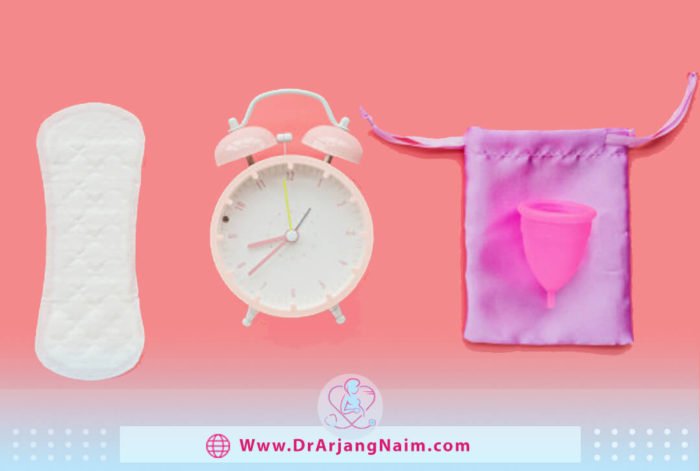Dysfunctional uterine bleeding (DUB) or abnormal uterine bleeding (AUB) can occur at different stages of a woman’s life. In this case, bleeding occurs outside the menstrual cycle. DUB can have many causes, but the most important is hormonal changes.
What is dysfunctional uterine bleeding(DUB)?
Abnormal uterine bleeding is a disorder of the menstrual cycle. Any bleeding outside the regular menstrual period and any change in the period’s amount or duration is also considered abnormal uterine bleeding. Normal vaginal or menstrual bleeding begins a new reproductive cycle every 21 to 35 days when the uterus drains its mucus. A menstrual period may last only a few days or a maximum of a week. Blood flow may be heavy or low and still be normal.
During the reproductive years, women may have experienced Dysfunctional Uterine Bleeding at least once. Abnormal uterine bleeding, which occurs only once, usually does not show any major problems, but if there is DUB for three consecutive months, there is probably a problem that a gynecologist should check. Girls who are just starting to menstruate or women who are in the last few years of their regular menstrual cycle or menopause are at higher risk for abnormal uterine bleeding.
Types of dysfunctional uterine bleeding(DUB)
There are different types of dysfunctional uterine bleeding. Menometrorrhagia is characterized by abnormal, heavy, prolonged, and irregular uterine bleeding.
Menorrhagia
Menorrhagia is a medical term for menstrual periods with abnormally heavy or prolonged bleeding. Although heavy menstrual bleeding is a common concern, most women do not experience enough bleeding to be defined as menorrhagia. With menorrhagia, everyday activities are not possible during menstruation because there is a lot of bleeding and cramping. Menorrhagia is the loss of more than 80 ml of menstrual blood during the period. Signs of menorrhagia may include:
- Wet one or more sanitary pads or tampons every hour for several hours in a row
- Needing to use double sanitary protection
- Needing to wake up to change sanitary protection during the night
- Bleeding for longer than a week
- Symptoms of anemia, such as fatigue, tiredness, or shortness of breath
Metrorrhagia
Metrorrhagia, commonly called intermenstrual bleeding today, is vaginal bleeding that occurs at irregular intervals and is unrelated to the menstrual cycle. As blood comes out of the uterus, like menstruation, bleeding does not indicate a normal period. Signs of menorrhagia may include:
- Light to heavy bleeding between regular menstrual periods
- Abdominal pain or cramps
Polymenorrhea
Polymenorrhea is a term used to describe the menstrual cycle shorter than 21 days. A normal menstrual cycle lasts between 24 and 38 days. For some women, a shorter period may be normal, but it may be due to some medical conditions for others. It can also affect fertility, as ovulation usually occurs earlier than expected or even over some time.
Oligomenorrhea
Oligomenorrhea refers to abnormally light bleeding or infrequent in people who menstruate. As a medical diagnosis, this specifically refers to when a menstrual cycle typically begins over 35 days, or a person has less than nine menstrual periods in a year.
Missing a period or Dysfunctional Uterine Bleeding in the menstrual cycle is not uncommon and is not necessarily a sign that something is wrong. Some changes in a person’s menstrual cycle are normal throughout life. However, if a person’s periods change suddenly and do not return to normal for most of her menstrual life, it is important to identify the change’s cause. Signs of Oligomenorrhea may include:
- Going longer than 35 days without a period
- Irregular menstrual cycles
- Periods that are lighter than usual
Symptoms of dysfunctional uterine bleeding (DUB)

DUB has different symptoms. The most common symptoms include:
- Breast tenderness
- Heavy menstrual bleeding
- Bleeding that lasts more than seven days
- Bleeding that occurs less than 21 days from the last cycle
- Spotting
- Bleeding between periods
- Bleeding that contains many clots or large clots
- Bloating
- Pelvic pain or pressure
If you experience any of the following severe symptoms of DUB, contact your doctor immediately:
- Passing large clots
- Soaking a pad every hour
- Pale skin
- Weakness
- Low blood pressure
- Increased heart rate
- Dizziness
- Fainting
4 Major causes of dysfunctional uterine bleeding (DUB)
There are four main reasons behind abnormal uterine bleeding.
1. Postcoital bleeding
Postcoital bleeding is vaginal bleeding in women after sexual intercourse and may or may not be painful. Bleeding can be from the uterus, cervix, vagina, and other tissues or organs adjacent to the vagina. Reasons for bleeding after sex include:
- Infections: Some infections can cause inflammation of the vaginal tissues, which can lead to bleeding. These infections are pelvic inflammatory disease, sexually transmitted infections, vaginitis, and cervicitis.
- Genitourinary syndrome of menopause (GSM): GSM was previously known as vaginal atrophy. This condition is more common in menopausal women who have had their ovaries removed. With age, especially when menstruation stops, the body produces less estrogen. When estrogen levels fall, the body produces less vaginal lubrication so the vagina can become dry and inflamed and lower estrogen levels. It also reduces vaginal traction. Vaginal tissues become more fragile, have less blood flow, and are more prone to rupture and irritation, eventually leading to discomfort, pain, and bleeding during sex.
- Vaginal dryness: Vaginal dryness can lead to bleeding. Factors such as childbirth, breastfeeding, certain medications, chemotherapy, radiation therapy, having intercourse before being fully aroused, and Sjogren’s syndrome can cause vaginal dryness.
- Polyps: Polyps are non-cancerous growths. It is sometimes seen in the cervix or the endometrium of the uterus. The movement of the polyp can irritate the surrounding tissue and cause bleeding from small blood vessels.
- Vaginal tearing: Sex, especially intense sex, can cause small cuts or scratches in the vagina.
- Cancer: Irregular vaginal bleeding, including bleeding after sex, is a common cervical or vaginal cancer symptom.
The gynecologists will first examine the vagina and cervix for Pap smears and possibly a biopsy to look for cancer. Once the doctor determines that it is not the cause of cancer, they will perform a more thorough examination to determine the cause of the bleeding.
Different treatments can be used depending on the cause of bleeding after sex. If the bleeding is due to vaginal dryness, vaginal moisturizers can help. Regular use of lubricants increases moisture and helps restore the natural acidity of the vagina. If vaginal dryness is due to menopause or ovarian resection, doctors may recommend treatments to increase estrogen, such as estrogen creams and suppositories, or use pills.
2. Hormonal imbalance
Hormone problems are the most common cause of abnormal uterine bleeding. For various reasons, such as menopause and adolescence, hormonal imbalances can lead to an irregular or heavy period or spotting between periods. The body needs accurate levels of hormones to function properly. Even minor imbalances can have significant effects, especially on the menstrual cycle. Various conditions and factors can cause hormone imbalance and thus affect the menstrual cycle. The most important factors include the following:
- Diabetes
- Thyroid problems
- Eating disorders
- Stress
- Tumors
- Primary ovarian insufficiency
- Tumors
- Polycystic ovary syndrome (PCOS)
A gynecologist uses blood tests, pelvic exams, and ultrasounds to diagnose hormonal imbalances. Treatment of hormonal imbalance depends on the cause. Some common treatment options include:
- Estrogen therapy
- Hormonal birth control
- Anti-androgen medications
- Testosterone therapy
3. Uterine fibroids and polyps
Uterine fibroids are non-cancerous growths of the uterus that often appear during the reproductive years. The size of a fibroid can range from a small seedling invisible to the human eye to large lumps that can cover the entire uterus. One of the symptoms of uterine fibroids is Irregularities in the menstrual cycle, accompanied by heavy bleeding. Uterine fibroids can develop for the following reasons:
- Genetic changes: Many fibroids contain changes in genes that are different from normal uterine muscle cells.
- Hormones: Estrogen and progesterone, two hormones that stimulate uterine growth, increase fibroid growth during each menstrual cycle in preparation for pregnancy. Fibroids shrink after menopause due to decreased hormone production.
- Extracellular matrix (ECM): ECM is a substance that binds cells together, like mortar between bricks. ECM grows in fibroids and fibrous them.
- Other growth factors: Substances that help the body maintain tissues, such as insulin-like growth factors, may affect fibroid growth.
Uterine fibroids are often found accidentally during routine pelvic exams. But if there are signs of fibroids, the doctor may use ultrasound, laboratory tests, and hysteroscopy.
There are many treatment options, such as medications, noninvasive, and minimally invasive procedures; the doctor selects the appropriate option based on the examinations performed.
Uterine polyps are growths attached to the inner wall of the uterus that spread to the uterine cavity. Overgrowth of cells in the uterus lining leads to uterine polyps, also called endometrial polyps. These polyps are usually non-cancerous, although some can be cancerous or eventually become cancerous. Uterine polyps can range in size from a few millimeters to several centimeters.
Hormonal factors appear to play a role in the development of polyps. Uterine polyps are sensitive to estrogen, meaning they grow in response to circulating estrogen. The gynecologist uses transvaginal ultrasound, hysteroscopy, and endometrial biopsy to diagnose polyps. Small, asymptomatic polyps may go away independently, but polyps with symptoms can be treated with medication or surgery.
4. Cancer cells of the uterus
Uterine cancer cells can cause Dysfunctional Uterine Bleeding. Endometrial cancer begins in the layer of cells that make up the lining of the uterus. Endometrial cancer is sometimes called uterine cancer. Other types of cancer can occur in the uterus, including uterine sarcoma, but are much less common than endometrial cancer. This cancer is often diagnosed in the early stages because it repeatedly causes abnormal bleeding from the vagina.
Doctors do not know what causes cancer. But mutations in cells cause cells to become cancerous. This mutation turns normal, healthy cells into abnormal cells. Healthy cells grow and multiply at a set rate and eventually die at a specific time. Abnormal cells grow and multiply out of control and do not die at a certain time. Abnormally accumulated cells form a tumor. Cancer cells invade nearby tissues, separate from the primary tumor, and spread to other body parts.
After taking a history of the patient, examining it, and finally diagnosing the abnormality, the doctor may order one or more of the following tests to collect a sample of tissue for testing:
- Endometrial biopsy: The doctor inserts a thin, flexible tube into the uterus through the cervix to suck a small piece of tissue out of the endometrium through the tube.
- Hysteroscopy: In this procedure, a thin, flexible tube with a fiber-optic camera is inserted into the uterus through the cervix. They use this endoscope to examine the endometrium and biopsy specimens of abnormalities visually.
- Dilation and curettage (D&C): If the biopsy results are unknown, the doctor may use D&C to collect another sample of endometrial tissue. To do this, they dilate the cervix and use a special tool to shave the tissue from the endometrium.
There are several treatment options for cancer. The physician’s recommended treatment plan depends on the type and stage of cancer and the patient’s overall health. Treatments include:
- Surgery: Cancer is often referred to as a type of surgery known as a hysterectomy. During a hysterectomy, the ovaries and fallopian tubes may be removed, and if cancer has spread to other parts of the body, the surgeon may recommend additional surgery.
- Radiation therapy: Radiation therapy uses high-energy radiation to kill cancer cells. There are two types of radiation therapy, external beam radiation therapy, and internal radiation therapy.
- Chemotherapy: Chemotherapy involves the administration of drugs that kill cancer cells. Some types of chemotherapy involve a single medication, while others involve a combination of drugs. Depending on the type of chemotherapy, the drugs are given as tablets or intravenously.
- Hormone therapy involves using hormones or hormone-blocking drugs to alter the body’s hormone levels, which can help reduce cancer cells’ growth.
Other reasons that cause dysfunctional uterine bleeding (DUB)

Other reasons cause abnormal uterine bleeding.
Obesity
Obesity causes menstrual irregularities; being overweight affects the number of hormones and insulin that can interfere with the menstrual cycle. Rapid weight gain can also cause dysfunctional uterine bleeding. Weight gain and irregular menstruation are common symptoms of PCOS and hypothyroidism and should be checked by a doctor.
Thickening of the uterine wall or lining
Thickening of the uterine wall or lining can be due to a hormonal imbalance or a medical condition that causes abnormal tissue growth, which can cause severe, prolonged, and irregular bleeding.
Hormonal birth control and IUDs
Hormonal contraceptives, including pills, vaginal rings, patches, and IUDs, can initially cause DUB. Sometimes it can take up to six months for the body to adjust to the new pregnancy control.
Excessive exercise
Excessive exercise and low-calorie intake cause significant stress on the body of young female athletes. The body’s response to this physiological stress reduces the ovaries’ stimulation by the hypothalamus and eventually stops ovulation, which results in changes in the menstrual cycle.
Stress
Stress can disrupt the menstrual cycle by temporarily interfering with the brain part that controls cycle-regulating hormones.
Living with dysfunctional uterine bleeding (DUB)
Abnormal uterine bleeding can negatively affect life. The inability to predict when the bleeding will start can cause anxiety. Also, heavy menstrual bleeding may limit daily activities during the menstrual cycle. For this reason, if you have Dysfunctional Uterine Bleeding, see a gynecologist.
Dr. Arjang Naim, MD, by obtaining accurate information from the patient, thorough examination, using the most up-to-date diagnostic methods in the world, first diagnoses the cause of DUB and, in the next stage, chooses the best treatment method to reduce the symptoms and the patient’s health.
Additional questions
- Can high TSH cause irregular periods?
Too much or too little thyroid hormone can make periods very light, heavy, or irregular. Thyroid disease can also cause periods to stop for a few months or longer, a condition called amenorrhea. If the immune system causes thyroid disease, other glands, including the ovaries, may become involved.
2. Is dysfunctional uterine bleeding serious?
Any uterine bleeding that occurs independently of menstruation or is heavier or longer than usual is known as abnormal uterine bleeding. Sometimes it can be a sign of a serious medical condition.
3. What are the two types of uterine dysfunction?
- Ovulatory dysfunction (AUB-O)—abnormal bleeding because not ovulating regularly
- Endometrial (AUB-E)—abnormal bleeding because of a problem with the lining of the uterus, like an infection
4. Will progesterone stop bleeding?
Progesterone pills can be used to treat heavy periods. Progesterone before menstruation prevents the growth of the uterine wall, which reduces bleeding during menstruation.
5. How does estrogen stop uterine bleeding?
In cases where the bleeding is prolonged and there is not enough tissue for the action of progesterone, estrogen therapy is performed to induce rapid growth of the endometrium. Another action of estrogen is to stimulate clotting at the capillary surface.
References
https://www.mayoclinic.org/diseases-conditions/endometrial-cancer/diagnosis-treatment/drc-20352466
https://www.mayoclinic.org/diseases-conditions/uterine-polyps/diagnosis-treatment/drc-20378713
https://www.healthline.com/health/hormonal-imbalance#natural-remedies
https://www.healthline.com/health/polymenorrhea
https://www.mayoclinic.org/diseases-conditions/menorrhagia/symptoms-causes/syc-20352829
https://www.verywellhealth.com/an-overview-of-oligomenorrhea-4584379
https://www.mayoclinic.org/diseases-conditions/uterine-fibroids/diagnosis-treatment/drc-20354294
https://www.health.harvard.edu/a_to_z/dysfunctional-uterine-bleeding-a-to-z




